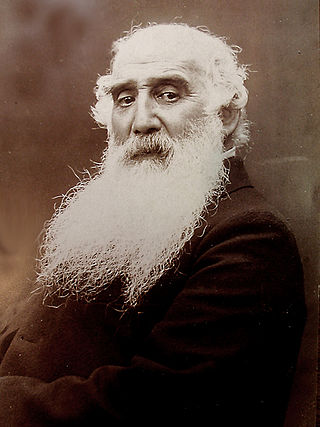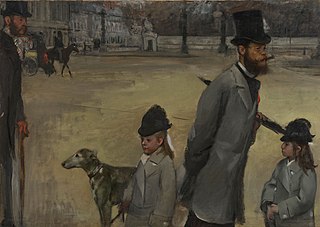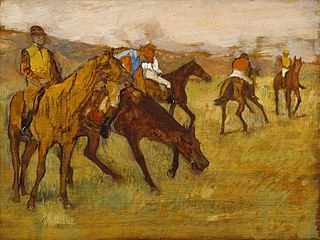
Jacob Abraham Camille Pissarro was a Danish-French Impressionist and Neo-Impressionist painter born on the island of St Thomas. His importance resides in his contributions to both Impressionism and Post-Impressionism. Pissarro studied from great forerunners, including Gustave Courbet and Jean-Baptiste-Camille Corot. He later studied and worked alongside Georges Seurat and Paul Signac when he took on the Neo-Impressionist style at the age of 54.

Édouard Manet was a French modernist painter. He was one of the first 19th-century artists to paint modern life, as well as a pivotal figure in the transition from Realism to Impressionism.

Impressionism was a 19th-century art movement characterized by relatively small, thin, yet visible brush strokes, open composition, emphasis on accurate depiction of light in its changing qualities, ordinary subject matter, unusual visual angles, and inclusion of movement as a crucial element of human perception and experience. Impressionism originated with a group of Paris-based artists whose independent exhibitions brought them to prominence during the 1870s and 1880s.

Mary Stevenson Cassatt was an American painter and printmaker. She was born in Allegheny, Pennsylvania, and lived much of her adult life in France, where she befriended Edgar Degas and exhibited with the Impressionists. Cassatt often created images of the social and private lives of women, with particular emphasis on the intimate bonds between mothers and children.

Pierre-Auguste Renoir was a French artist who was a leading painter in the development of the Impressionist style. As a celebrator of beauty and especially feminine sensuality, it has been said that "Renoir is the final representative of a tradition which runs directly from Rubens to Watteau."

Edgar Degas was a French Impressionist artist famous for his pastel drawings and oil paintings.

American Impressionism was a style of painting related to European Impressionism and practiced by American artists in the United States from the mid-nineteenth century through the beginning of the twentieth. The style is characterized by loose brushwork and vivid colors with a wide array of subject matters but focusing on landscapes and upper-class domestic life.

Portraits at the Stock Exchange is a painting by the French artist Edgar Degas. Completed in about 1879, the painting was already in the collection of the French banker Ernest May when it was listed in the catalogue of the fourth Impressionist exhibition that year. It may also have been shown in the next Impressionist exhibit in 1880, but it was not well known until it entered the collections of the Louvre in 1923. The canvas shows an interior corner of the open trading floor of the Paris Stock Exchange. May stands in the center of the picture wearing a top hat and pince-nez, listening to his colleague, a certain M. Bolâtre, leaning over his shoulder. They are likely discussing a document, possibly a bordereau, held aloft by a partially obscured third party.

Place de la Concorde or Viscount Lepic and his Daughters Crossing the Place de la Concorde is an 1875 oil painting by Edgar Degas. It depicts the cigar-smoking Ludovic-Napoléon Lepic, his daughters Eylau and Jeanine, his dog, and a solitary man on the left at Place de la Concorde in Paris. The man on the left may be the playwright Ludovic Halévy. The Tuileries Gardens can be seen in the background, behind a stone wall.

Paul Durand-Ruel was a French art dealer associated with the Impressionists and the Barbizon School. Being the first to support artists such as Claude Monet, Camille Pissarro, and Pierre-Auguste Renoir, he is known for his innovations in modernizing art markets, and is generally considered to be the most important art dealer of the 19th century. An ambitious entrepreneur, Durand-Ruel cultivated international interest in French artists by establishing art galleries and exhibitions in London, New York, Berlin, Brussels, among other places. Additionally, he played a role in the decentralization of art markets in France, which prior to the mid-19th century was monopolized by the Salon system.

The Child's Bath is an 1893 oil painting by American artist Mary Cassatt. The painting continues her interest in depicting bathing and motherhood, but it is distinct in its angle of vision. Both the subject matter and the overhead perspective were inspired by Japanese Woodcut prints and Edgar Degas.

The Regatta at Sainte-Adresse is an oil-on-canvas painting by the impressionist painter Claude Monet. It was painted in 1867 and is owned by the Metropolitan Museum of Art.

Springtime or The Reader is an 1872 painting by the French Impressionist painter Claude Monet. It depicts his first wife, Camille Doncieux, seated reading beneath a canopy of lilacs. The painting is presently held by the Walters Art Museum.

Before the Race (1882–1884) is a painting by Impressionist painter, Edgar Degas, who began painting scenes with horses in the 1860s.

The Dance Class is an 1874 oil painting on canvas by the French artist Edgar Degas. It is in the collection of the Metropolitan Museum of Art, in New York.

Mother and Child (The Oval Mirror) is an oil-on-canvas painting by the American Impressionist artist Mary Cassatt. The painting depicts a mother and her child in front of a mirror. The painting provides a glimpse of the domestic life of a mother and her child, evoking religious iconography from the Italian Renaissance. However, portrayals of a mother and her child are common in Cassatt's work, so it is possible that this similarity is coincidental rather than intentional.
Antonin Personnaz was a French art collector and early colour photographer.

A Woman and a Girl Driving is an oil-on-canvas painting by American Impressionist Mary Cassatt, painted in 1881. It emphasizes the theme of female autonomy in a male dominated society. Lydia Cassatt, the artist's sister, is shown holding the reins of the family's carriage alongside Odile Fèvre, the niece of Edgar Degas, and a servant to the family, Mathieu, traveling through the Bois de Boulogne in Paris. Emphasizing Lydia's position of command, Cassatt draws attention to the evolving perceptions of female identity in the late 19th century. The painting serves to challenge prevailing social norms of the time and unveil the range of female experience.

La Place du Théâtre Français is an 1898 oil painting by Danish-French Impressionist and Neo-Impressionist painter Camille Pissarro. It is at the Los Angeles County Museum of Art in Los Angeles, USA, but it is currently not on public display. It is one of the approximately 15 paintings that Pissarro made while staying at the Hôtel du Louvre in Paris.
Hippolyte Jouvin (1825–1889) was a French photographer and publisher of stereoscopic photographs. He is considered a pioneer in the field of photogravure, and was one of the first photographers to use wet collodion process.



















